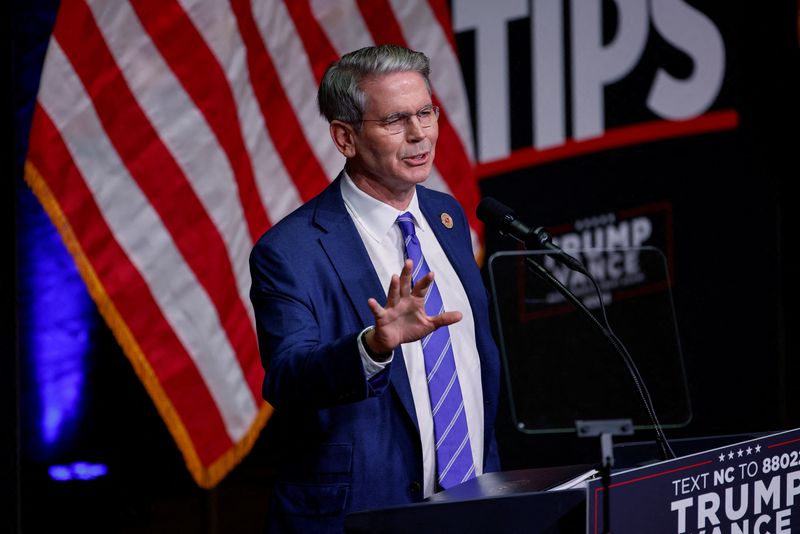
(Reuters) – Donald Trump on Friday said he would nominate Scott Bessent to be the 79th U.S. Treasury secretary and frontman for the president-elect’s aggressive economic policies, a slate that financial markets already anticipate will add to economic growth in the near term but also rekindle inflation.
Here are five charts sensitive to that agenda that the incoming cabinet official may want to keep on his radar:
BALLOONING US DEBT
The U.S. is already more than $35 trillion in debt, with roughly $28 trillion of that floated in the global bond market in the form of U.S. Treasury securities.
Total (EPA:TTEF) debt grew by more than $7.8 trillion in Trump’s first term, with Treasury debt rising by $7.2 trillion. Under President Joe Biden, total debt is up by a further $8.2 trillion, including nearly $7 trillion of new Treasury market debt.
Those totals, according to the latest baseline forecast from the Congressional Budget Office – which does not take into account Trump’s ambitions for additional tax cuts and tariffs – are expected to rise to about $42 trillion and $35 trillion, respectively, by the end of 2028 just before the Republican president-elect’s second term in the White House expires.
Often touted as the safest asset pool on Earth, the Treasury market nonetheless has grown increasingly sensitive to the rapid growth of the federal debt, with concerns over just how much longer global investors will be willing to fund the country’s liabilities at advantageous interest rates.
DEFICIT OUTPACING GROWTH
In light of Trump’s desire to lower taxes, which is likely to reduce tax revenues, Bessent will have to hope the cuts stimulate economic growth that outpaces growth in the federal budget deficit.
Bessent has said he would like to reduce the deficit as a share of gross domestic product to 3%. For fiscal 2024, which ended on Sept. 30, it was 7.8% of real – or inflation-adjusted – GDP. It has not been 3% or below since 2015 during the Obama administration.
In Trump’s first term, it ranged from 3.4% in fiscal 2017 to 15.2% in fiscal 2020, a year when COVID-19 pandemic relief spending blew out the deficit.
The CBO’s projection underestimated the actual deficit-to-GDP ratio in 2024, but its baseline forecast estimates it at 6.1% next year and 5.6% just before Trump leaves office. It then starts to expand again beginning in 2030.
INTEREST ON THE DEBT
Federal debt service costs topped $1 trillion in fiscal 2024 for the first time on a combination of more debt and higher interest rates resulting from two years of Federal Reserve rate increases to rein in inflation. Interest on the debt in the last fiscal year was exceeded only by the Social Security retirement program as a spending line item.
And, even as the Fed has started cutting interest rates, Treasury yields have risen notably in the last two months in anticipation of much of Trump’s agenda taking effect – and the country’s borrowing costs have continued rising with them.
So far, recent auctions of new U.S. bonds have been well bid, but that is not guaranteed should the market size continue its rapid growth.
RED-HOT GREENBACK
The U.S. dollar has been on a tear, climbing more than 7% since late September against a basket of major trading partners’ currencies, and is at its strongest level in about two years.
A strong dollar will help mute some of the inflationary impetus of the Trump economic agenda, with currency effects making imported goods cheaper. But it will make U.S. exports less attractive, complicating any effort to put a dent in the trade deficit even with the expanded slate of tariffs Trump has in mind to slow the flow of imports.
THAT PESKY FED
Bessent will be the chief liaison between the Fed and the administration. Fed Chair Jerome Powell meets most weeks with the Treasury secretary – now Janet Yellen and Steven Mnuchin before her – giving the new secretary ample opportunity to offer views on what is going on with Fed policy, particularly interest rates.
Trump famously soured on Powell soon after elevating him from Fed governor to the U.S. central bank’s chief because Powell continued with a rate-increasing regime begun by his predecessor, who happened to be Yellen.
As Trump takes office this time, the Fed is in the process of lowering rates – but perhaps not as much as central bank officials themselves had anticipated just two months ago and perhaps also not as much as Trump would like to see.
That’s because inflation is again proving to be a bit slower in returning to the Fed’s 2% target, and the job market – the other focus of the dual mandate assigned it by Congress – remains pretty healthy.
Powell’s term as chair expires in May 2026, and if history is a guide, Bessent could be an influential voice advising Trump on who next to pick to lead the central bank. Earlier this year Bessent floated the idea of nominating Powell’s successor as early as possible to undercut Powell’s authority – a so-called “shadow chair” appointment – but he has since backed away from the idea.






